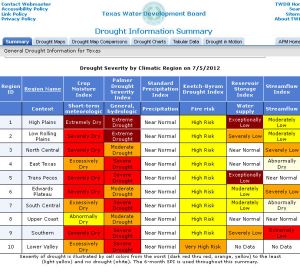!['California Drought Dry Riverbed 2009' by National Oceanic and Atmospheric Administration (National Oceanic and Atmospheric Administration) [Public domain], via Wikimedia Commons California_Drought_Dry_Riverbed_2009](https://prismrm.files.wordpress.com/2012/07/california_drought_dry_riverbed_2009.jpg?w=300&h=225) Texas, along with other states and regions of the country, is experiencing an historic drought. In addition to the wildfires that caused billions in damage around the state last year, drought conditions have caused critical water shortages. Small towns and water-intensive industries have been particularly hard-hit. Public sector functions, particularly public utilities, are often the first to feel the effects of water scarcity. The risk quickly moves into the private sector, affecting industries like agriculture and, eventually, any business that relies on running water. Recent reports suggest that much of the private sector has not planned for the risks associated with water scarcity. Businesses that rely on available water may suffer, as may those that invest in utilities and other water-dependent enterprises.
Texas, along with other states and regions of the country, is experiencing an historic drought. In addition to the wildfires that caused billions in damage around the state last year, drought conditions have caused critical water shortages. Small towns and water-intensive industries have been particularly hard-hit. Public sector functions, particularly public utilities, are often the first to feel the effects of water scarcity. The risk quickly moves into the private sector, affecting industries like agriculture and, eventually, any business that relies on running water. Recent reports suggest that much of the private sector has not planned for the risks associated with water scarcity. Businesses that rely on available water may suffer, as may those that invest in utilities and other water-dependent enterprises.
According to the Texas Water Development Board (TWDB), drought conditions currently affect all regions of the state. The various indices of drought conditions, precipitation, and fire risk range from above average to extreme. The Edwards Plateau, which encompasses most of the Texas Hill Country and includes the city of Austin, is experiencing a “moderate” drought on the TWDB’s scale. The crop moisture index for the region is “severely dry,” just below the highest index of “extremely dry,” and the region is at high risk for fire.
The current drought is testing the limits of the competing claims to surface water in Texas’ complicated system of water rights. The system dates back to Spanish colonial land grants, with principles from the English legal system added in later. The Texas Commission on Environmental Quality (TCEQ), which grants and monitors water use permits, must balance the competing needs of permit holders and other claimants. More and more frequently, this means suspending one permit holder in favor of another, often based on seniority. It also means uncertainty for any one business or organization when it comes to their own access to water.
Water scarcity has affected consumers by limiting the amount of water available for commercial and everyday use. In one case, the Lower Colorado River Authority (LCRA) had to deliver water from the Colorado River by tanker truck to the community of Spicewood Beach in Burnet County. The TWDB recently predicted that the problem will only get worse, with the state’s population expected to double by 2060 while the water supply declines. In the agriculture sector, the LCRA has withheld irrigation water from rice farmers (which is sourced in the Highland Lakes area northwest of Austin) because of the extremely low water levels in the lakes.
The impact of water scarcity that may most directly harm private enterprise is the impact on energy production and similar utilities. Power generation, including coal, natural gas, and other sources, relies heavily on water. This directly affects industrial production throughout Texas and the country. Businesses that rely on water availability and those that hold interests in public utilities must factor trends in water scarcity into their risk management plans.
Prism Risk Management provides businesses and organizations with risk and loss prevention consulting and offers services in loss control planning. To learn how our team can help your organization, contact us today online or at (512) 901-0070.
More Blog Posts:
U.S. Utilities Face Cybersecurity Risks as Hacker Attacks Mount, Prism Risk Management Blog, June 11, 2012
Austin Young Lawyers’ Association Fundraiser: “Judges for Joplin,” Prism Risk Management Blog, June 3, 2011
Freeze Warning, Prism Risk Management Blog, February 7, 2011
Photo credit: ‘California Drought Dry Riverbed 2009’ by National Oceanic and Atmospheric Administration (National Oceanic and Atmospheric Administration) [Public domain], via Wikimedia Commons.
